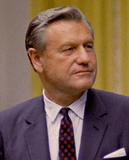Republican Party presidential primaries, 1968
|
| |||||||||||||||||||||||||||||||||||||||||
| |||||||||||||||||||||||||||||||||||||||||
| |||||||||||||||||||||||||||||||||||||||||
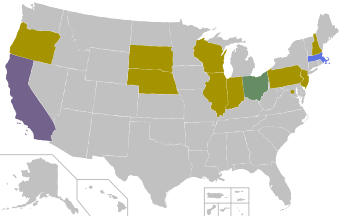 Gold denotes a state won by Richard Nixon. Blue denotes a state won by Nelson Rockefeller. Green denotes a state won by James A. Rhodes. Purple denotes a state won by Ronald Reagan. Grey denotes a state that did not hold a primary. | |||||||||||||||||||||||||||||||||||||||||
| |||||||||||||||||||||||||||||||||||||||||
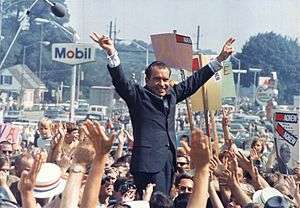
The 1968 Republican presidential primaries were the selection process by which voters of the Republican Party chose its nominee for President of the United States in the 1968 U.S. presidential election. Former Vice President Richard Nixon was selected as the nominee through a series of primary elections and caucuses culminating in the 1968 Republican National Convention held from August 5 to August 8, 1968, in Miami Beach, Florida.[1]
Primary race
Nixon was the front-runner for the Republican nomination and to a great extent the story of the Republican primary campaign and nomination is the story of one Nixon opponent after another entering the race and then dropping out.
Nixon's first challenger was Michigan Governor George W. Romney. A Gallup poll in mid-1967 showed Nixon with 39%, followed by Romney with 25%. However, in a slip of the tongue, Romney told a news reporter that he had been "brainwashed" by the military and the diplomatic corps into supporting the Vietnam War; the remark led to weeks of ridicule in the national news media. As the year 1968 opened, Romney was opposed to further American intervention in Vietnam and had decided to run as the Republican version of Eugene McCarthy (New York Times 2/18/1968). Romney's support faded slowly, and he withdrew from the race on February 28, 1968. (New York Times 2/29/1968).
Nixon won a resounding victory in the important New Hampshire primary on March 12, winning 78% of the vote. Antiwar Republicans wrote in the name of New York Governor Nelson Rockefeller, the leader of the GOP's liberal wing, who received 11% of the vote and became Nixon's new challenger. Nixon led Rockefeller in the polls throughout the primary campaign. Rockefeller defeated Nixon in the Massachusetts primary on April 30 but otherwise fared poorly in the state primaries and conventions.
By early spring, California Governor Ronald Reagan, the leader of the GOP's conservative wing, had become Nixon's chief rival. In the Nebraska primary on May 14, Nixon won with 70% of the vote to 21% for Reagan and 5% for Rockefeller. While this was a wide margin for Nixon, Reagan remained Nixon's leading challenger. Nixon won the next primary of importance, Oregon, on May 15 with 65% of the vote and won all the following primaries except for California (June 4), where only Reagan appeared on the ballot. Reagan's margin in California gave him a plurality of the nationwide primary vote, but when the Republican National Convention assembled, Nixon had 656 delegates according to a UPI poll (with 667 needed for the nomination).
Four candidates won states in the primary, a record not equaled in Republican primaries until 2016 when four candidates (Donald Trump, Ted Cruz, Marco Rubio, and John Kasich) won at least one state. (However, in 2012, three candidates (Mitt Romney, Rick Santorum, and Newt Gingrich) won states and a fourth (Ron Paul) won a contest in a territory, the Virgin Islands. For comparison, the 1968 Democratic primary saw five candidates win states.
Total popular vote
- Ronald Reagan – 1,696,632 (37.93%)
- Richard Nixon – 1,679,443 (37.54%)
- James A. Rhodes – 614,492 (13.74%)
- Nelson A. Rockefeller – 164,340 (3.67%)
- Unpledged – 140,639 (3.14%)
- Eugene McCarthy (write-in) – 44,520 (1.00%)
- Harold Stassen – 31,655 (0.71%)
- John Volpe – 31,465 (0.70%)
- Others – 21,456 (0.51%)
- George Wallace (write-in) – 15,291 (0.34%)
- Robert Kennedy (write-in) – 14,524 (0.33%)
- Hubert Humphrey (write-in) – 5,698 (0.13)
- Lyndon Johnson (write-in) – 4,824 (0.11%)
- George Romney – 4,447 (0.10%)
- Raymond P. Shafer – 1,223 (0.03%)
- William W. Scranton – 724 (0.02%)
- Charles H. Percy – 689 (0.02%)
- Barry M. Goldwater – 598 (0.01%)
- John V. Lindsay – 591 (0.01%)
Statewide contests by winner
| Ronald Reagan | Richard Nixon | James Rhodes | Nelson Rockefeller | Others | Unpledged | ||
|---|---|---|---|---|---|---|---|
| March 12 | New Hampshire | 0.3% | 77.6% | - | 10.8% | 11.3% | - |
| April 2 | Wisconsin | 10.5% | 79.7% | - | 1.6% | 8.2% | - |
| April 23 | Pennsylvania | 2.8% | 59.4% | - | 18.3% | 19.5% | - |
| April 30 | Massachusetts | 1.7% | 25.8% | - | 30.0% | 45.5%[4] | - |
| May 7 | Indiana | - | 100% | - | - | - | - |
| May 7 | Ohio | - | - | 100% | - | - | - |
| May 7 | Washington, D.C. | _ | 90.11% | - | - | - | 9.89% |
| May 14 | Nebraska | 21.3% | 70.0% | - | 5.1% | 3.6% | - |
| May 14 | West Virginia | - | - | - | - | - | 100% |
| May 28 | Florida | - | - | - | - | - | 100% |
| May 28 | Oregon | 20.4% | 65.1% | - | 11.6% | 2.9% | - |
| June 4 | California | 100% | - | - | - | - | - |
| June 4 | New Jersey | 3.2% | 83.4% | - | 13.4% | - | - |
| June 4 | South Dakota | - | 100% | - | - | - | - |
| June 11 | Illinois | 7.1% | 78.1% | - | 9.7% | 5.1% | - |
- Italics - Write-In Votes
The convention
At the 1968 Republican National Convention in Miami Beach, Florida, Reagan and Rockefeller planned to unite their forces in a stop-Nixon movement, but the strategy fell apart when neither man agreed to support the other for the nomination. Nixon won the nomination on the first ballot. Nixon then chose Maryland Governor Spiro Agnew to be his Vice-Presidential candidate, despite complaints from within the GOP that Agnew was an unknown quantity, and that a better-known and more popular candidate, such as Romney, should have been the Vice-Presidential nominee. It was also reported that Nixon's first choice for running mate was his longtime friend and ally, Robert Finch, who was Lt. Governor of California since 1967 and later his HEW Secretary, but Finch declined the offer and, in any case, had he run he would have put the Republican ticket at a disadvantage as the Constitution prevents a member of the Electoral College from voting for both President and Vice-President from the Elector's home state.
| President | (before switches) | (after switches) | Vice President | Vice-Presidential votes |
|---|---|---|---|---|
| Richard M. Nixon | 692 | 1238 | Spiro T. Agnew | 1119 |
| Nelson Rockefeller | 277 | 93 | George Romney | 186 |
| Ronald Reagan | 182 | 2 | John V. Lindsay | 10 |
| Ohio Governor James A. Rhodes | 55 | — | Massachusetts Senator Edward Brooke | 1 |
| Michigan Governor George Romney | 50 | — | James A. Rhodes | 1 |
| New Jersey Senator Clifford Case | 22 | — | Not Voting | 16 |
| Kansas Senator Frank Carlson | 20 | — | — | |
| Arkansas Governor Winthrop Rockefeller | 18 | — | — | |
| Hawaii Senator Hiram Fong | 14 | — | — | |
| Harold Stassen | 2 | — | — | |
| New York City Mayor John V. Lindsay | 1 | — | — |
Candidates
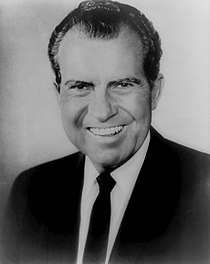
Former Vice President
Richard Nixon
of California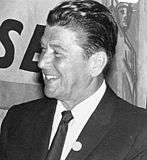
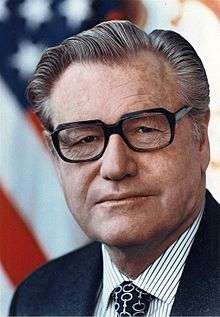
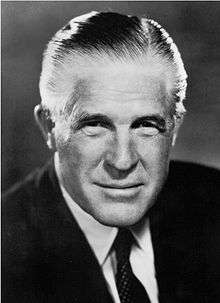
Governor
George Romney
of Michigan
(Withdrew Feb. 28th, 1968)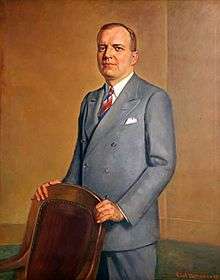
Former Governor
Harold Stassen
of Minnesota
Favorite sons
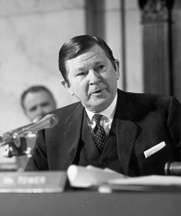
Senator
John Tower
of Texas
(Withdrew July 1)
(Endorsed Richard Nixon)
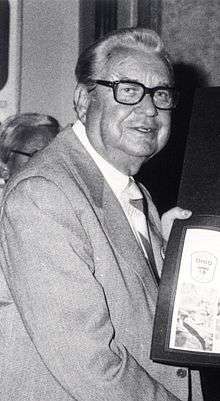

Senator
Clifford Case
of New Jersey
(Withdrew Before 1st Ballot)
(Endorsed Richard Nixon)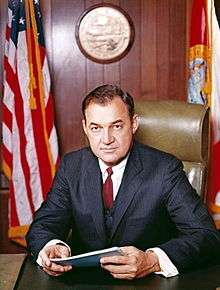
Governor
Claude R. Kirk, Jr.
of Florida
(Withdrew July 12)
(Endorsed Nelson Rockefeller)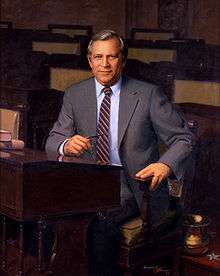
Senator
Howard Baker
of Tennessee
(Withdrew May 16)
(Endorsed Richard Nixon)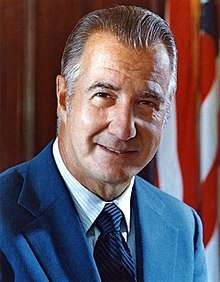
Governor
Spiro Agnew
of Maryland
(Withdrew August 6)
(Became Nixon's running mate)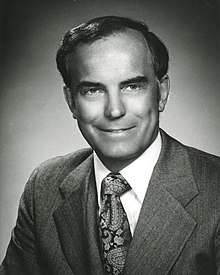
Governor
Daniel J. Evans
of Washington
(Withdrew August 5)
(Endorsed Nelson Rockefeller)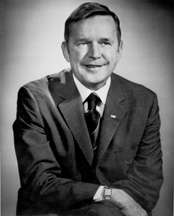
Governor
Dewey F. Bartlett
of Oklahoma
(Withdrew August 4)
(Endorsed Richard Nixon)
Senator
Strom Thurmond
of South Carolina
(Withdrew Before 1st Ballot)
(Endorsed Richard Nixon).jpg)
Senator
Frank Carlson
of Kansas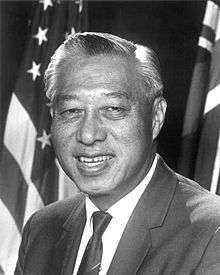
Senator
Hiram Fong
of Hawaii
Governor
Wally Hickel
of Alaska
(Withdrew Before 1st Ballot)
(Endorsed Richard Nixon)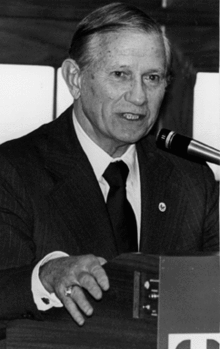
Governor
John Volpe
of Massachusetts
(Withdrew April 30, 1968)
See also
References
- ↑ "Guide to U.S. Elections - Google Books". Books.google.com. 2016-02-19. Retrieved 2016-02-19.
- ↑ "Results of the 15 Presidential Primaries in 1968." In CQ Almanac 1968, 24th ed., 19-971-19-973. Washington, DC: Congressional Quarterly, 1969. http://library.cqpress.com/cqalmanac/cqal68-1282595.
- ↑ "Chronology of Political Events: Nov. 1967—Nov. 1968." In CQ Almanac 1968, 24th ed., 19-974-19-978. Washington, DC: Congressional Quarterly, 1969. http://library.cqpress.com/cqalmanac/cqal68-1282597.
- ↑ Including John A. Volpe, at 29.5%.
- ↑ Troy, Schlesinger & Israel 2012, pp. 1318-1319.
Bibliography
- Troy, Gil; Schlesinger, Arthur M.; Israel, Fred L. (2012). History of American Presidential Elections, 1789–2008. 3 (4 ed.). New York City: Facts on File. ISBN 978-0-8160-8220-9.
